ICT Professional Practice: Smith Engineering Ethical Dilemma Report
VerifiedAdded on 2023/01/05
|8
|2089
|95
Report
AI Summary
This report analyzes an ethical dilemma at Smith Engineering, an engineering firm facing challenges with its tender document template. The case study explores conflicts of interest surrounding the selection of new ICT solutions, including Report Base, Report Builder, and a potential in-house project. Using the "Doing Ethics Technique," the report identifies stakeholders, ethical issues, and implications, particularly focusing on conflict of interest, transparency, and the ability of the options to meet the organization's needs. The analysis considers the impact of decisions on various stakeholders, including the individual tasked with choosing the best solution, the head of the CIO department, and the companies offering the software solutions. The report concludes that the best course of action involves escalating the issue to top management to ensure fairness and transparency in the decision-making process.
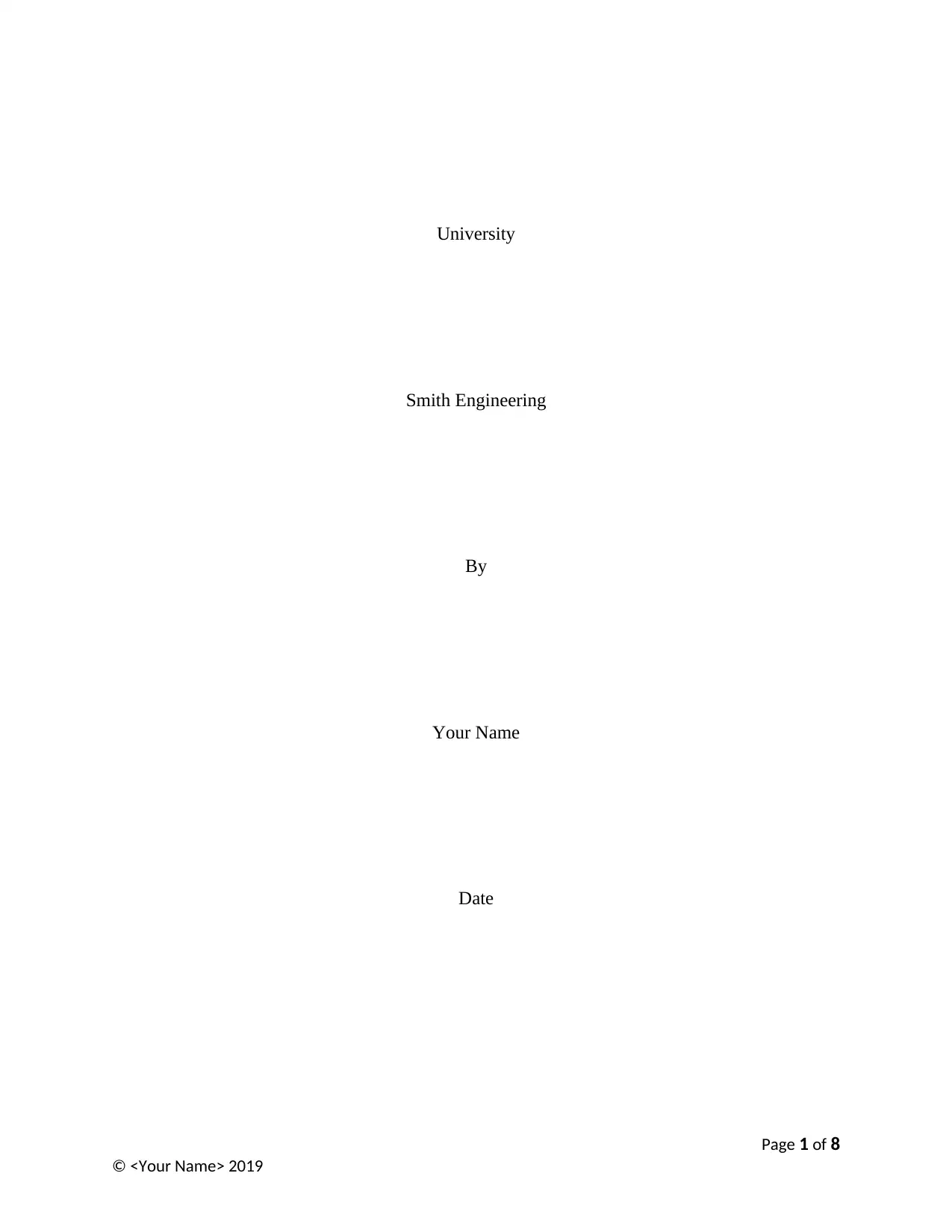
University
Smith Engineering
By
Your Name
Date
Page 1 of 8
© <Your Name> 2019
Smith Engineering
By
Your Name
Date
Page 1 of 8
© <Your Name> 2019
Paraphrase This Document
Need a fresh take? Get an instant paraphrase of this document with our AI Paraphraser
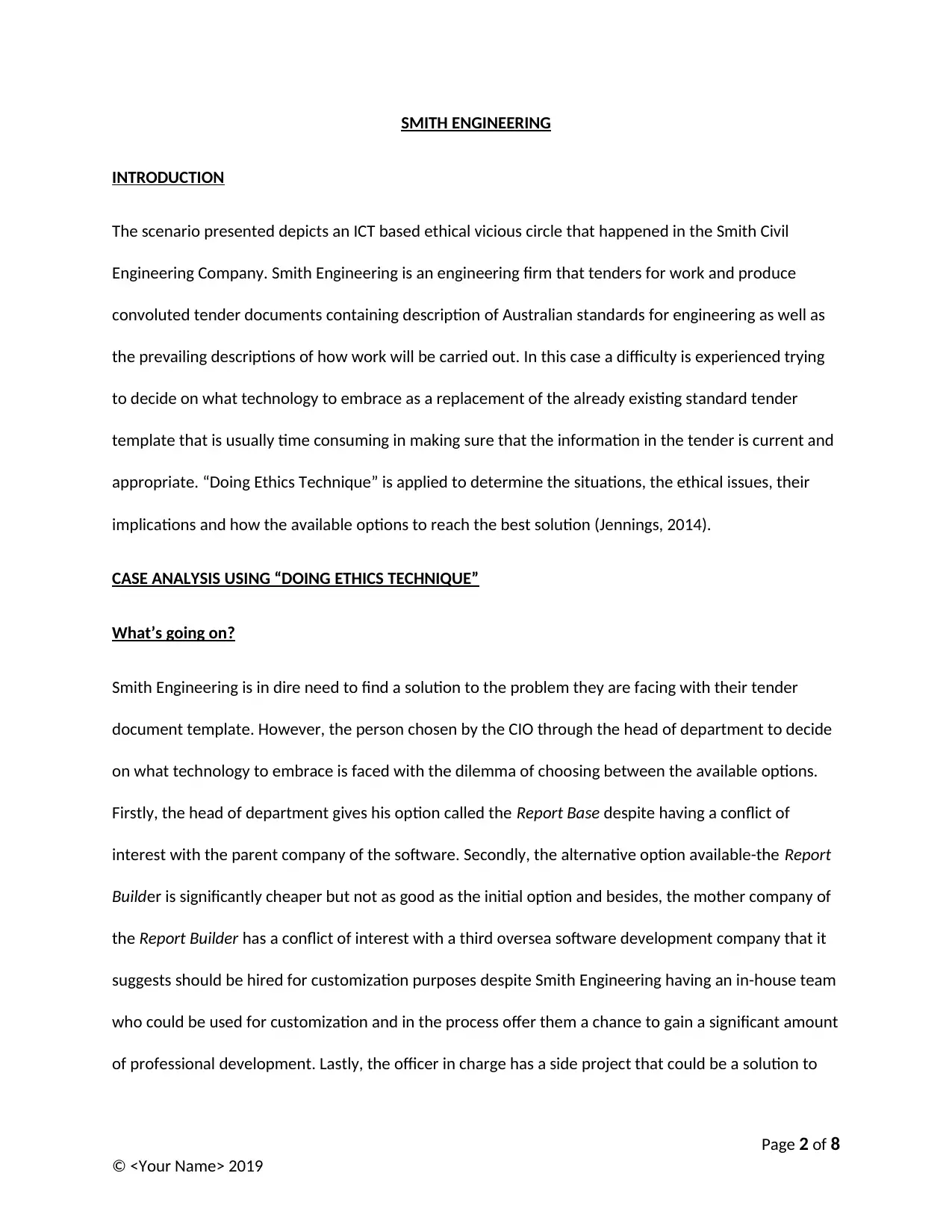
SMITH ENGINEERING
INTRODUCTION
The scenario presented depicts an ICT based ethical vicious circle that happened in the Smith Civil
Engineering Company. Smith Engineering is an engineering firm that tenders for work and produce
convoluted tender documents containing description of Australian standards for engineering as well as
the prevailing descriptions of how work will be carried out. In this case a difficulty is experienced trying
to decide on what technology to embrace as a replacement of the already existing standard tender
template that is usually time consuming in making sure that the information in the tender is current and
appropriate. “Doing Ethics Technique” is applied to determine the situations, the ethical issues, their
implications and how the available options to reach the best solution (Jennings, 2014).
CASE ANALYSIS USING “DOING ETHICS TECHNIQUE”
What’s going on?
Smith Engineering is in dire need to find a solution to the problem they are facing with their tender
document template. However, the person chosen by the CIO through the head of department to decide
on what technology to embrace is faced with the dilemma of choosing between the available options.
Firstly, the head of department gives his option called the Report Base despite having a conflict of
interest with the parent company of the software. Secondly, the alternative option available-the Report
Builder is significantly cheaper but not as good as the initial option and besides, the mother company of
the Report Builder has a conflict of interest with a third oversea software development company that it
suggests should be hired for customization purposes despite Smith Engineering having an in-house team
who could be used for customization and in the process offer them a chance to gain a significant amount
of professional development. Lastly, the officer in charge has a side project that could be a solution to
Page 2 of 8
© <Your Name> 2019
INTRODUCTION
The scenario presented depicts an ICT based ethical vicious circle that happened in the Smith Civil
Engineering Company. Smith Engineering is an engineering firm that tenders for work and produce
convoluted tender documents containing description of Australian standards for engineering as well as
the prevailing descriptions of how work will be carried out. In this case a difficulty is experienced trying
to decide on what technology to embrace as a replacement of the already existing standard tender
template that is usually time consuming in making sure that the information in the tender is current and
appropriate. “Doing Ethics Technique” is applied to determine the situations, the ethical issues, their
implications and how the available options to reach the best solution (Jennings, 2014).
CASE ANALYSIS USING “DOING ETHICS TECHNIQUE”
What’s going on?
Smith Engineering is in dire need to find a solution to the problem they are facing with their tender
document template. However, the person chosen by the CIO through the head of department to decide
on what technology to embrace is faced with the dilemma of choosing between the available options.
Firstly, the head of department gives his option called the Report Base despite having a conflict of
interest with the parent company of the software. Secondly, the alternative option available-the Report
Builder is significantly cheaper but not as good as the initial option and besides, the mother company of
the Report Builder has a conflict of interest with a third oversea software development company that it
suggests should be hired for customization purposes despite Smith Engineering having an in-house team
who could be used for customization and in the process offer them a chance to gain a significant amount
of professional development. Lastly, the officer in charge has a side project that could be a solution to
Page 2 of 8
© <Your Name> 2019
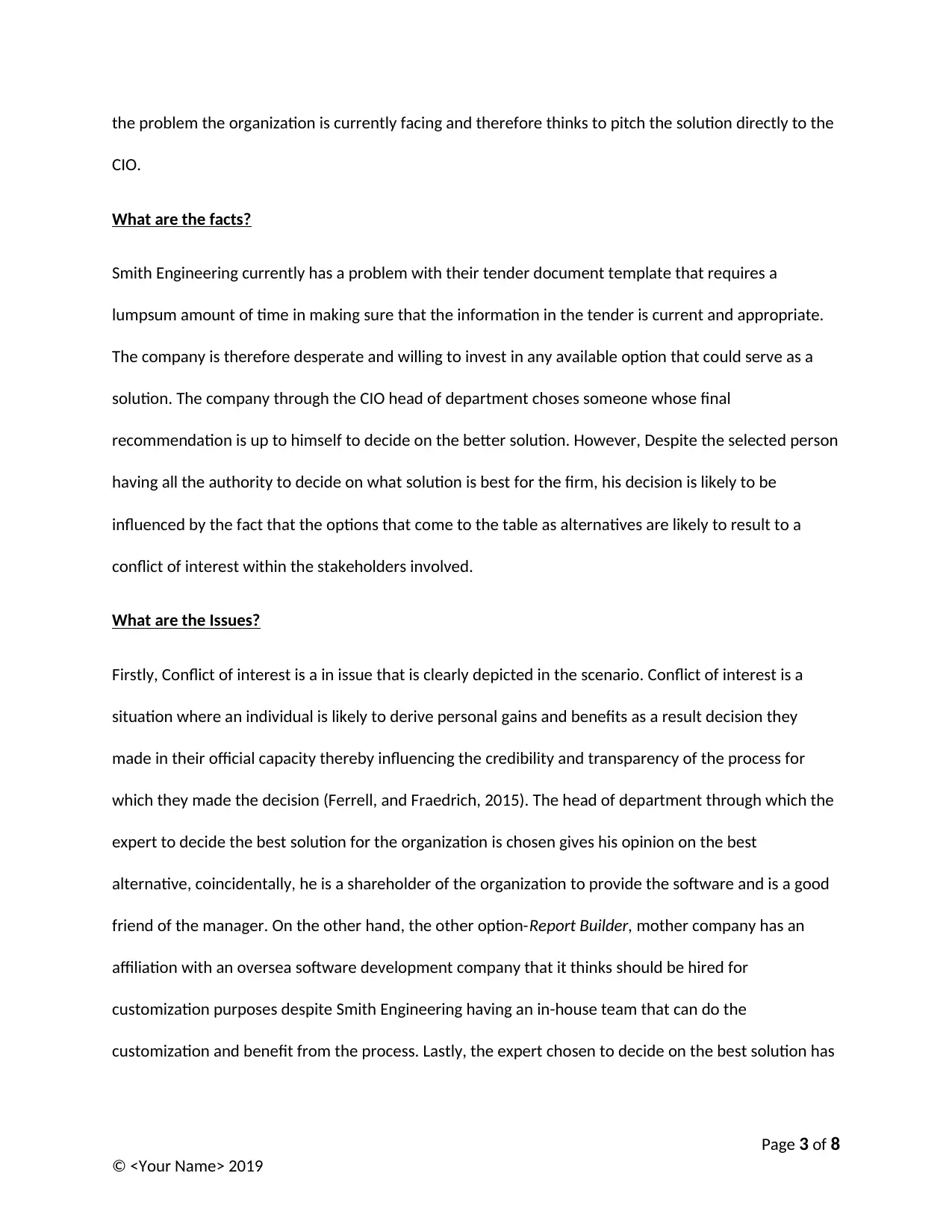
the problem the organization is currently facing and therefore thinks to pitch the solution directly to the
CIO.
What are the facts?
Smith Engineering currently has a problem with their tender document template that requires a
lumpsum amount of time in making sure that the information in the tender is current and appropriate.
The company is therefore desperate and willing to invest in any available option that could serve as a
solution. The company through the CIO head of department choses someone whose final
recommendation is up to himself to decide on the better solution. However, Despite the selected person
having all the authority to decide on what solution is best for the firm, his decision is likely to be
influenced by the fact that the options that come to the table as alternatives are likely to result to a
conflict of interest within the stakeholders involved.
What are the Issues?
Firstly, Conflict of interest is a in issue that is clearly depicted in the scenario. Conflict of interest is a
situation where an individual is likely to derive personal gains and benefits as a result decision they
made in their official capacity thereby influencing the credibility and transparency of the process for
which they made the decision (Ferrell, and Fraedrich, 2015). The head of department through which the
expert to decide the best solution for the organization is chosen gives his opinion on the best
alternative, coincidentally, he is a shareholder of the organization to provide the software and is a good
friend of the manager. On the other hand, the other option-Report Builder, mother company has an
affiliation with an oversea software development company that it thinks should be hired for
customization purposes despite Smith Engineering having an in-house team that can do the
customization and benefit from the process. Lastly, the expert chosen to decide on the best solution has
Page 3 of 8
© <Your Name> 2019
CIO.
What are the facts?
Smith Engineering currently has a problem with their tender document template that requires a
lumpsum amount of time in making sure that the information in the tender is current and appropriate.
The company is therefore desperate and willing to invest in any available option that could serve as a
solution. The company through the CIO head of department choses someone whose final
recommendation is up to himself to decide on the better solution. However, Despite the selected person
having all the authority to decide on what solution is best for the firm, his decision is likely to be
influenced by the fact that the options that come to the table as alternatives are likely to result to a
conflict of interest within the stakeholders involved.
What are the Issues?
Firstly, Conflict of interest is a in issue that is clearly depicted in the scenario. Conflict of interest is a
situation where an individual is likely to derive personal gains and benefits as a result decision they
made in their official capacity thereby influencing the credibility and transparency of the process for
which they made the decision (Ferrell, and Fraedrich, 2015). The head of department through which the
expert to decide the best solution for the organization is chosen gives his opinion on the best
alternative, coincidentally, he is a shareholder of the organization to provide the software and is a good
friend of the manager. On the other hand, the other option-Report Builder, mother company has an
affiliation with an oversea software development company that it thinks should be hired for
customization purposes despite Smith Engineering having an in-house team that can do the
customization and benefit from the process. Lastly, the expert chosen to decide on the best solution has
Page 3 of 8
© <Your Name> 2019
⊘ This is a preview!⊘
Do you want full access?
Subscribe today to unlock all pages.

Trusted by 1+ million students worldwide
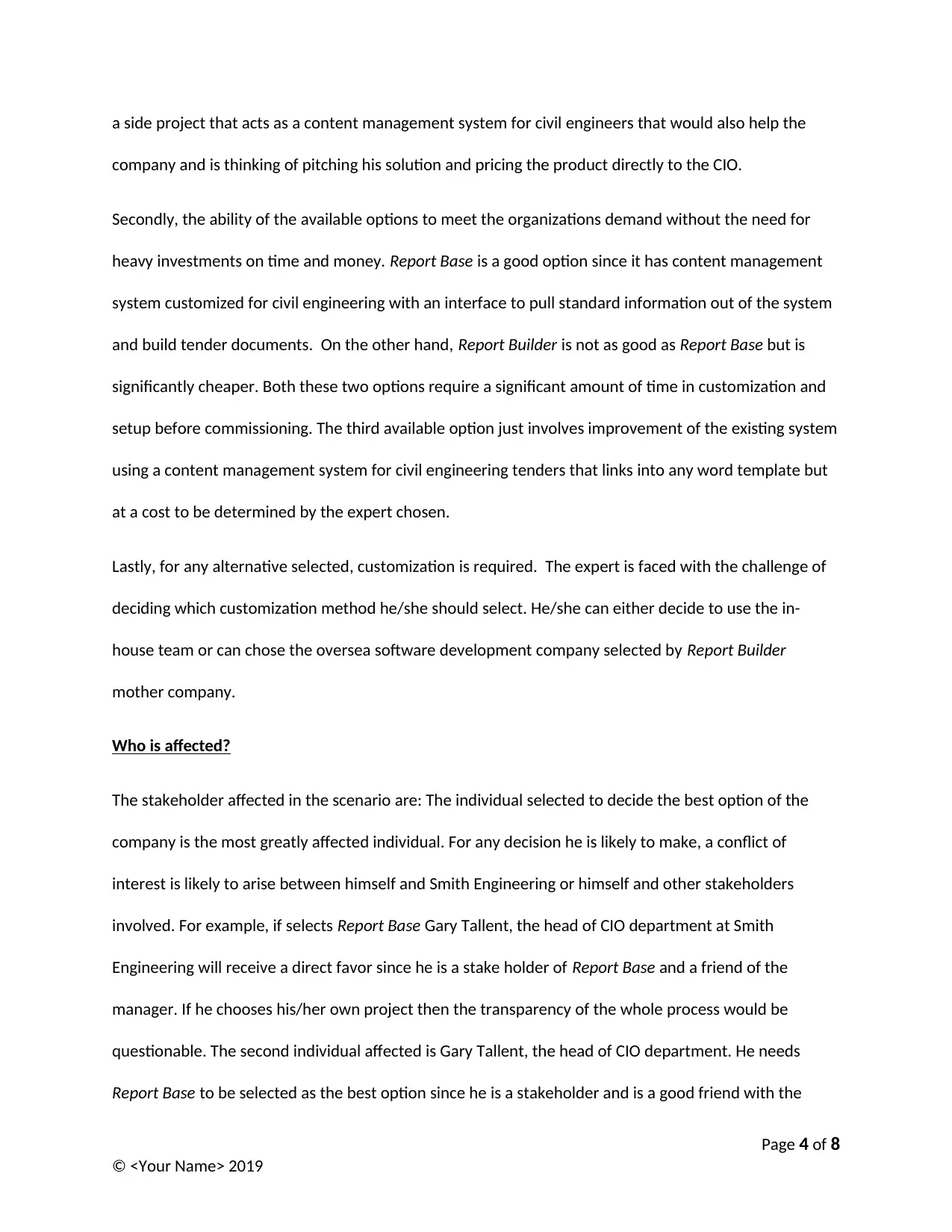
a side project that acts as a content management system for civil engineers that would also help the
company and is thinking of pitching his solution and pricing the product directly to the CIO.
Secondly, the ability of the available options to meet the organizations demand without the need for
heavy investments on time and money. Report Base is a good option since it has content management
system customized for civil engineering with an interface to pull standard information out of the system
and build tender documents. On the other hand, Report Builder is not as good as Report Base but is
significantly cheaper. Both these two options require a significant amount of time in customization and
setup before commissioning. The third available option just involves improvement of the existing system
using a content management system for civil engineering tenders that links into any word template but
at a cost to be determined by the expert chosen.
Lastly, for any alternative selected, customization is required. The expert is faced with the challenge of
deciding which customization method he/she should select. He/she can either decide to use the in-
house team or can chose the oversea software development company selected by Report Builder
mother company.
Who is affected?
The stakeholder affected in the scenario are: The individual selected to decide the best option of the
company is the most greatly affected individual. For any decision he is likely to make, a conflict of
interest is likely to arise between himself and Smith Engineering or himself and other stakeholders
involved. For example, if selects Report Base Gary Tallent, the head of CIO department at Smith
Engineering will receive a direct favor since he is a stake holder of Report Base and a friend of the
manager. If he chooses his/her own project then the transparency of the whole process would be
questionable. The second individual affected is Gary Tallent, the head of CIO department. He needs
Report Base to be selected as the best option since he is a stakeholder and is a good friend with the
Page 4 of 8
© <Your Name> 2019
company and is thinking of pitching his solution and pricing the product directly to the CIO.
Secondly, the ability of the available options to meet the organizations demand without the need for
heavy investments on time and money. Report Base is a good option since it has content management
system customized for civil engineering with an interface to pull standard information out of the system
and build tender documents. On the other hand, Report Builder is not as good as Report Base but is
significantly cheaper. Both these two options require a significant amount of time in customization and
setup before commissioning. The third available option just involves improvement of the existing system
using a content management system for civil engineering tenders that links into any word template but
at a cost to be determined by the expert chosen.
Lastly, for any alternative selected, customization is required. The expert is faced with the challenge of
deciding which customization method he/she should select. He/she can either decide to use the in-
house team or can chose the oversea software development company selected by Report Builder
mother company.
Who is affected?
The stakeholder affected in the scenario are: The individual selected to decide the best option of the
company is the most greatly affected individual. For any decision he is likely to make, a conflict of
interest is likely to arise between himself and Smith Engineering or himself and other stakeholders
involved. For example, if selects Report Base Gary Tallent, the head of CIO department at Smith
Engineering will receive a direct favor since he is a stake holder of Report Base and a friend of the
manager. If he chooses his/her own project then the transparency of the whole process would be
questionable. The second individual affected is Gary Tallent, the head of CIO department. He needs
Report Base to be selected as the best option since he is a stakeholder and is a good friend with the
Page 4 of 8
© <Your Name> 2019
Paraphrase This Document
Need a fresh take? Get an instant paraphrase of this document with our AI Paraphraser
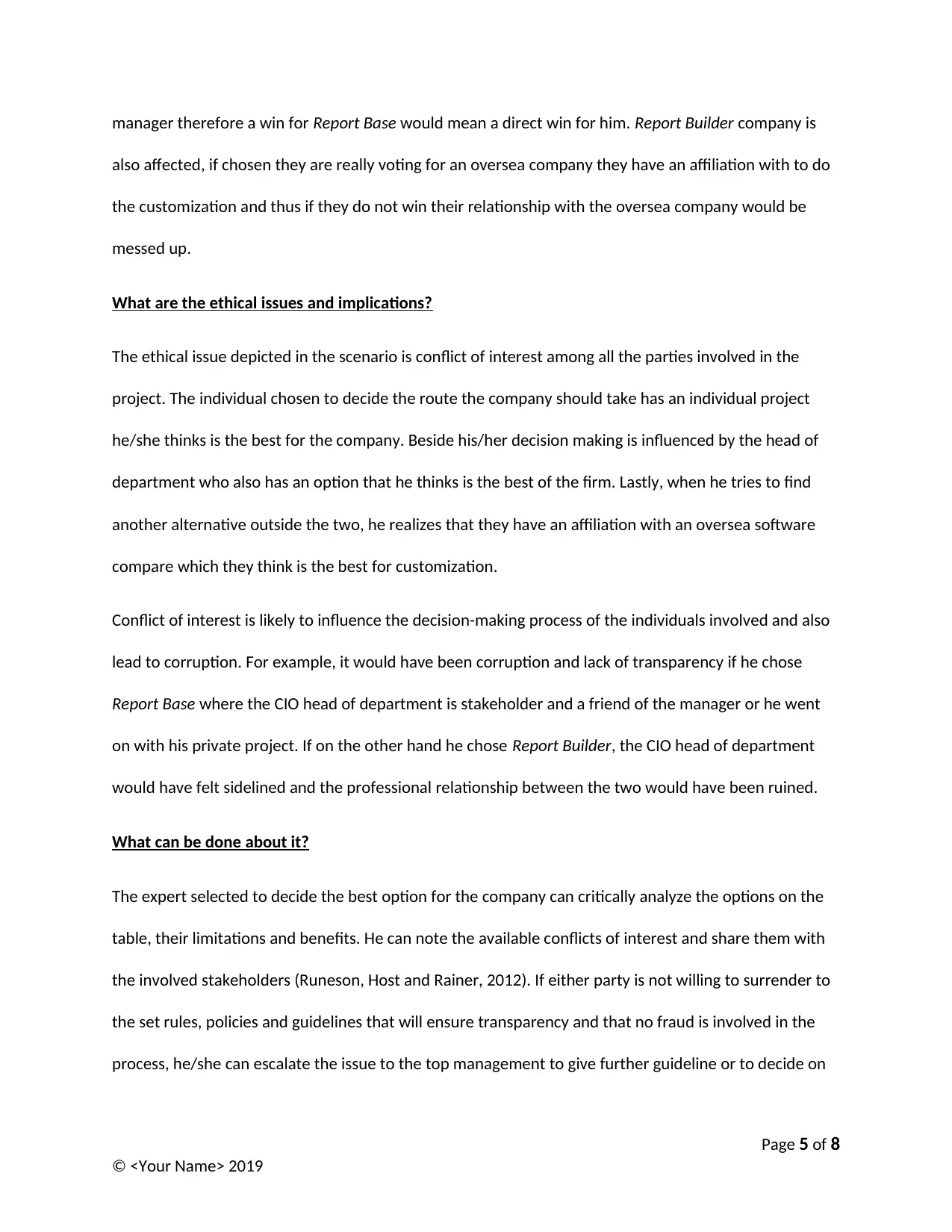
manager therefore a win for Report Base would mean a direct win for him. Report Builder company is
also affected, if chosen they are really voting for an oversea company they have an affiliation with to do
the customization and thus if they do not win their relationship with the oversea company would be
messed up.
What are the ethical issues and implications?
The ethical issue depicted in the scenario is conflict of interest among all the parties involved in the
project. The individual chosen to decide the route the company should take has an individual project
he/she thinks is the best for the company. Beside his/her decision making is influenced by the head of
department who also has an option that he thinks is the best of the firm. Lastly, when he tries to find
another alternative outside the two, he realizes that they have an affiliation with an oversea software
compare which they think is the best for customization.
Conflict of interest is likely to influence the decision-making process of the individuals involved and also
lead to corruption. For example, it would have been corruption and lack of transparency if he chose
Report Base where the CIO head of department is stakeholder and a friend of the manager or he went
on with his private project. If on the other hand he chose Report Builder, the CIO head of department
would have felt sidelined and the professional relationship between the two would have been ruined.
What can be done about it?
The expert selected to decide the best option for the company can critically analyze the options on the
table, their limitations and benefits. He can note the available conflicts of interest and share them with
the involved stakeholders (Runeson, Host and Rainer, 2012). If either party is not willing to surrender to
the set rules, policies and guidelines that will ensure transparency and that no fraud is involved in the
process, he/she can escalate the issue to the top management to give further guideline or to decide on
Page 5 of 8
© <Your Name> 2019
also affected, if chosen they are really voting for an oversea company they have an affiliation with to do
the customization and thus if they do not win their relationship with the oversea company would be
messed up.
What are the ethical issues and implications?
The ethical issue depicted in the scenario is conflict of interest among all the parties involved in the
project. The individual chosen to decide the route the company should take has an individual project
he/she thinks is the best for the company. Beside his/her decision making is influenced by the head of
department who also has an option that he thinks is the best of the firm. Lastly, when he tries to find
another alternative outside the two, he realizes that they have an affiliation with an oversea software
compare which they think is the best for customization.
Conflict of interest is likely to influence the decision-making process of the individuals involved and also
lead to corruption. For example, it would have been corruption and lack of transparency if he chose
Report Base where the CIO head of department is stakeholder and a friend of the manager or he went
on with his private project. If on the other hand he chose Report Builder, the CIO head of department
would have felt sidelined and the professional relationship between the two would have been ruined.
What can be done about it?
The expert selected to decide the best option for the company can critically analyze the options on the
table, their limitations and benefits. He can note the available conflicts of interest and share them with
the involved stakeholders (Runeson, Host and Rainer, 2012). If either party is not willing to surrender to
the set rules, policies and guidelines that will ensure transparency and that no fraud is involved in the
process, he/she can escalate the issue to the top management to give further guideline or to decide on
Page 5 of 8
© <Your Name> 2019
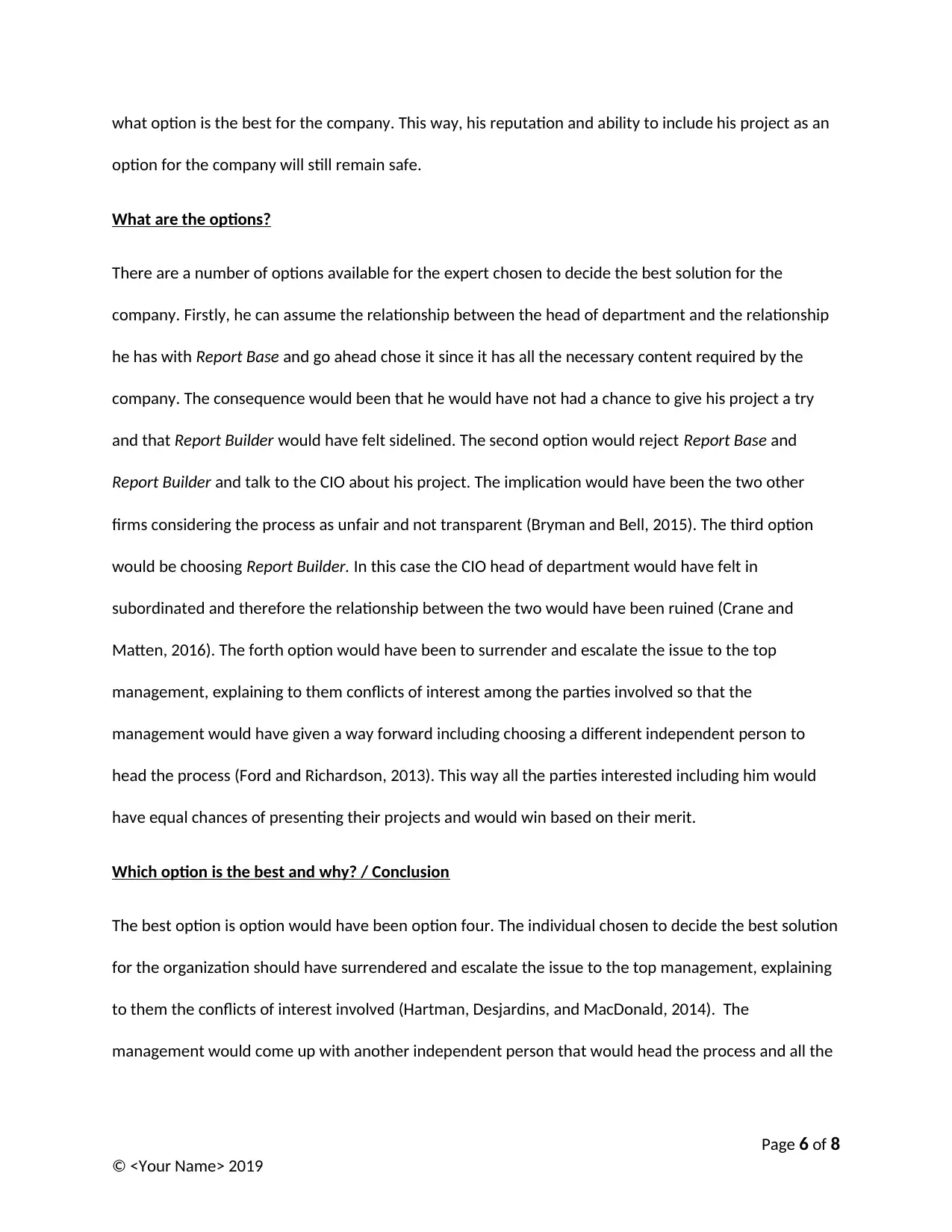
what option is the best for the company. This way, his reputation and ability to include his project as an
option for the company will still remain safe.
What are the options?
There are a number of options available for the expert chosen to decide the best solution for the
company. Firstly, he can assume the relationship between the head of department and the relationship
he has with Report Base and go ahead chose it since it has all the necessary content required by the
company. The consequence would been that he would have not had a chance to give his project a try
and that Report Builder would have felt sidelined. The second option would reject Report Base and
Report Builder and talk to the CIO about his project. The implication would have been the two other
firms considering the process as unfair and not transparent (Bryman and Bell, 2015). The third option
would be choosing Report Builder. In this case the CIO head of department would have felt in
subordinated and therefore the relationship between the two would have been ruined (Crane and
Matten, 2016). The forth option would have been to surrender and escalate the issue to the top
management, explaining to them conflicts of interest among the parties involved so that the
management would have given a way forward including choosing a different independent person to
head the process (Ford and Richardson, 2013). This way all the parties interested including him would
have equal chances of presenting their projects and would win based on their merit.
Which option is the best and why? / Conclusion
The best option is option would have been option four. The individual chosen to decide the best solution
for the organization should have surrendered and escalate the issue to the top management, explaining
to them the conflicts of interest involved (Hartman, Desjardins, and MacDonald, 2014). The
management would come up with another independent person that would head the process and all the
Page 6 of 8
© <Your Name> 2019
option for the company will still remain safe.
What are the options?
There are a number of options available for the expert chosen to decide the best solution for the
company. Firstly, he can assume the relationship between the head of department and the relationship
he has with Report Base and go ahead chose it since it has all the necessary content required by the
company. The consequence would been that he would have not had a chance to give his project a try
and that Report Builder would have felt sidelined. The second option would reject Report Base and
Report Builder and talk to the CIO about his project. The implication would have been the two other
firms considering the process as unfair and not transparent (Bryman and Bell, 2015). The third option
would be choosing Report Builder. In this case the CIO head of department would have felt in
subordinated and therefore the relationship between the two would have been ruined (Crane and
Matten, 2016). The forth option would have been to surrender and escalate the issue to the top
management, explaining to them conflicts of interest among the parties involved so that the
management would have given a way forward including choosing a different independent person to
head the process (Ford and Richardson, 2013). This way all the parties interested including him would
have equal chances of presenting their projects and would win based on their merit.
Which option is the best and why? / Conclusion
The best option is option would have been option four. The individual chosen to decide the best solution
for the organization should have surrendered and escalate the issue to the top management, explaining
to them the conflicts of interest involved (Hartman, Desjardins, and MacDonald, 2014). The
management would come up with another independent person that would head the process and all the
Page 6 of 8
© <Your Name> 2019
⊘ This is a preview!⊘
Do you want full access?
Subscribe today to unlock all pages.

Trusted by 1+ million students worldwide
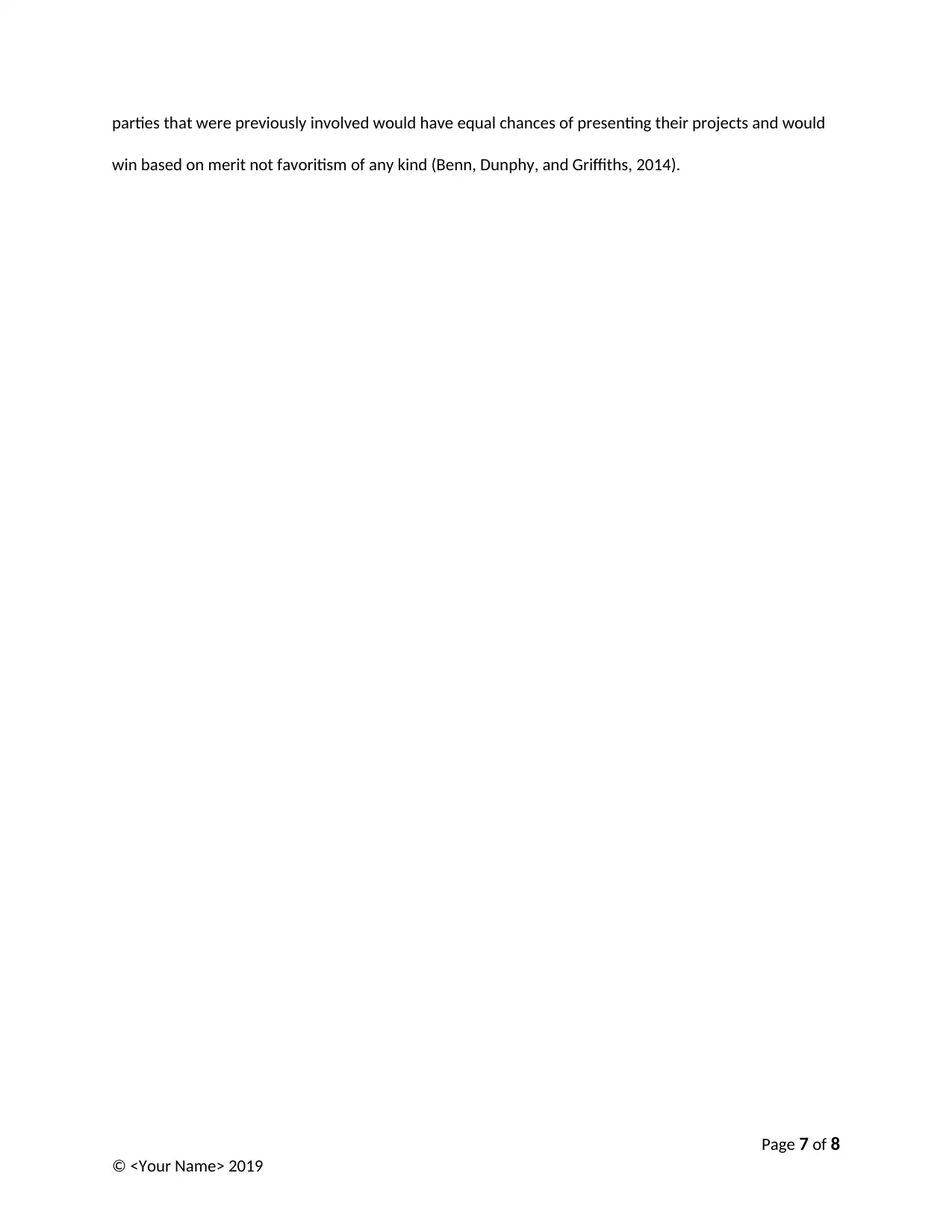
parties that were previously involved would have equal chances of presenting their projects and would
win based on merit not favoritism of any kind (Benn, Dunphy, and Griffiths, 2014).
Page 7 of 8
© <Your Name> 2019
win based on merit not favoritism of any kind (Benn, Dunphy, and Griffiths, 2014).
Page 7 of 8
© <Your Name> 2019
Paraphrase This Document
Need a fresh take? Get an instant paraphrase of this document with our AI Paraphraser
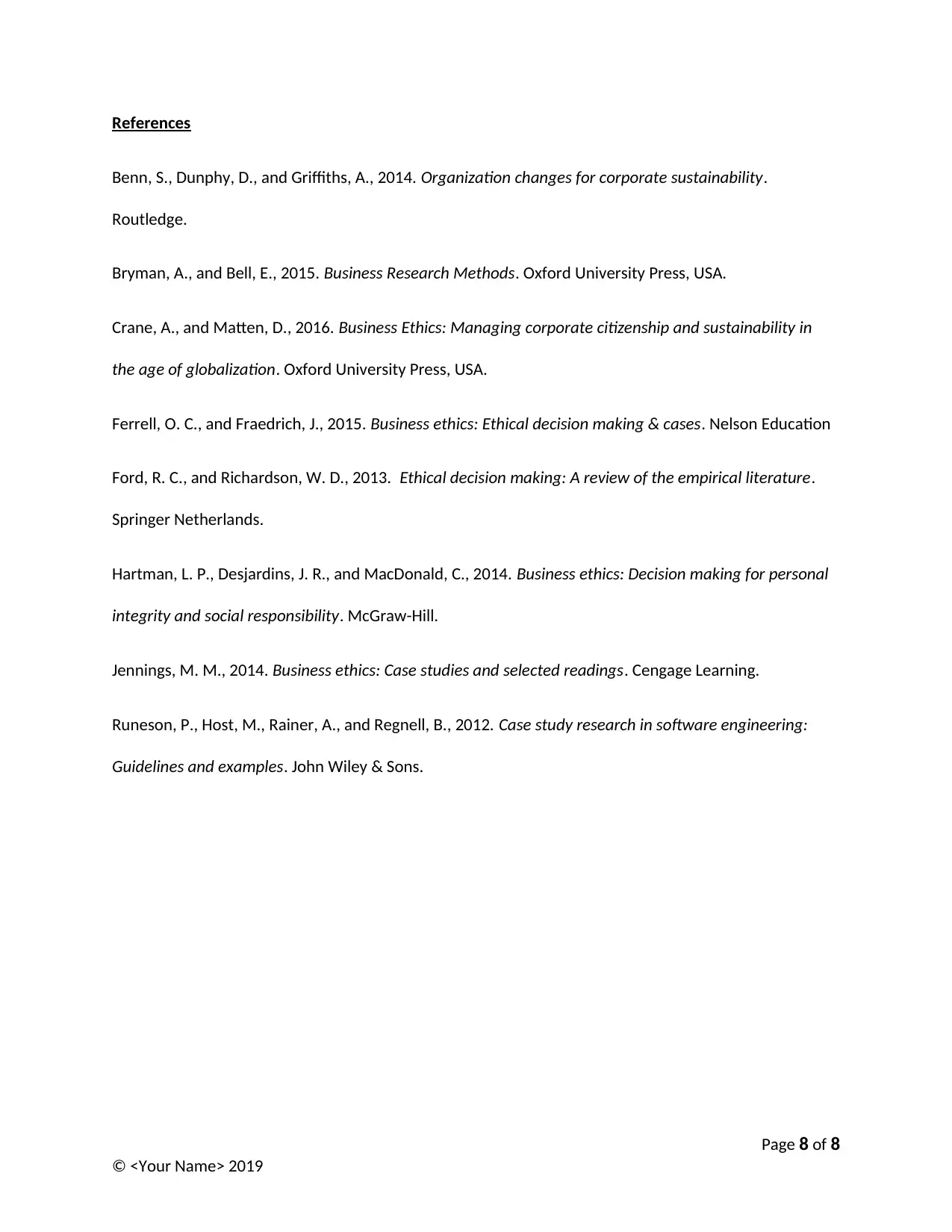
References
Benn, S., Dunphy, D., and Griffiths, A., 2014. Organization changes for corporate sustainability.
Routledge.
Bryman, A., and Bell, E., 2015. Business Research Methods. Oxford University Press, USA.
Crane, A., and Matten, D., 2016. Business Ethics: Managing corporate citizenship and sustainability in
the age of globalization. Oxford University Press, USA.
Ferrell, O. C., and Fraedrich, J., 2015. Business ethics: Ethical decision making & cases. Nelson Education
Ford, R. C., and Richardson, W. D., 2013. Ethical decision making: A review of the empirical literature.
Springer Netherlands.
Hartman, L. P., Desjardins, J. R., and MacDonald, C., 2014. Business ethics: Decision making for personal
integrity and social responsibility. McGraw-Hill.
Jennings, M. M., 2014. Business ethics: Case studies and selected readings. Cengage Learning.
Runeson, P., Host, M., Rainer, A., and Regnell, B., 2012. Case study research in software engineering:
Guidelines and examples. John Wiley & Sons.
Page 8 of 8
© <Your Name> 2019
Benn, S., Dunphy, D., and Griffiths, A., 2014. Organization changes for corporate sustainability.
Routledge.
Bryman, A., and Bell, E., 2015. Business Research Methods. Oxford University Press, USA.
Crane, A., and Matten, D., 2016. Business Ethics: Managing corporate citizenship and sustainability in
the age of globalization. Oxford University Press, USA.
Ferrell, O. C., and Fraedrich, J., 2015. Business ethics: Ethical decision making & cases. Nelson Education
Ford, R. C., and Richardson, W. D., 2013. Ethical decision making: A review of the empirical literature.
Springer Netherlands.
Hartman, L. P., Desjardins, J. R., and MacDonald, C., 2014. Business ethics: Decision making for personal
integrity and social responsibility. McGraw-Hill.
Jennings, M. M., 2014. Business ethics: Case studies and selected readings. Cengage Learning.
Runeson, P., Host, M., Rainer, A., and Regnell, B., 2012. Case study research in software engineering:
Guidelines and examples. John Wiley & Sons.
Page 8 of 8
© <Your Name> 2019
1 out of 8
Your All-in-One AI-Powered Toolkit for Academic Success.
+13062052269
info@desklib.com
Available 24*7 on WhatsApp / Email
![[object Object]](/_next/static/media/star-bottom.7253800d.svg)
Unlock your academic potential
Copyright © 2020–2025 A2Z Services. All Rights Reserved. Developed and managed by ZUCOL.

